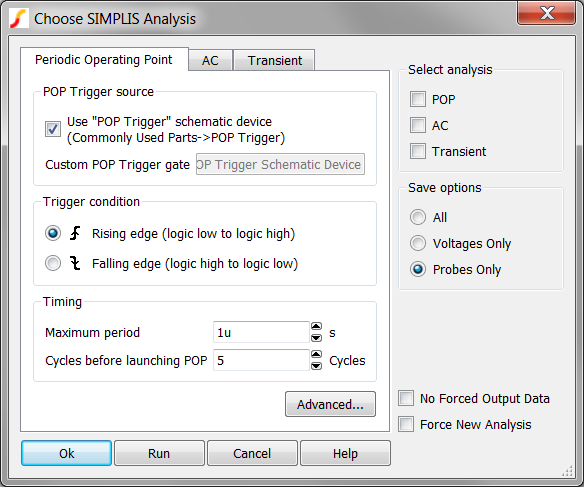Periodic Operating Point
Periodic Operating Point (POP) analysis finds a steady-state operating point of switched systems that are periodically driven or self-oscillating. The predominant application of this analysis mode is to rapidly find the settled condition of a switching power supply without having to simulate the entire power-up sequence. This dramatically speeds up the analysis of the design behavior under different load conditions.
A POP analysis requires a trigger signal to indicate the start of each periodic cycle. You have two methods to add this trigger to your schematic.
- The best method is to use a special schematic part by following these steps to place
the trigger on your schematic:
- If the parts selector is not shown, select from the menu bar.
- Click the arrow to open the Commonly Used Parts category.
- Select POP Trigger from the bottom of the list.
- The other method is to specify a full part reference of the device in the Choose Analysis... dialog box as noted in step 3 of Setting up a POP Analysis.
-
Note: This is needed only when the schematic hierarchy is converted to an ASCII text model. SIMPLIS cannot find the schematic symbol in a model which has been reduced to an ASCII text definition.
For more information about POP analysis, see the SIMPLIS Reference Manual ().
Setting up a POP Analysis
- From the menu bar, select
- Check POP in the Select analysis section on the right side of the dialog box.
- Click the Periodic Operating Point tab, and then enter the values which are
shown explained below.

Parameter Description POP Trigger source - Use "POP Trigger" Schematic Device POP analysis requires a trigger signal to indicate the start of each periodic cycle. The best way to define this is using a special schematic part. Trigger gate If you do not check the option above to use the schematic POP trigger device, you must specify a suitable part in this field by entering the full part reference of the device. Trigger Condition The polarity of the trigger edge as specified by the following two parameters. Maximum period You should set this to a value that is larger than the expected switching cycle, but it should be less than twice the expected switching cycle to prevent unintentional POP convergence on a sub-harmonic oscillation. Note: During each run, SIMPLIS expects to see valid trigger conditions. However, if there is a fault in the design of the circuit or a fault in the definition of the trigger conditions, it is possible that none will be detected. The maximum period parameter prevents SIMPLIS from carrying on indefinitely in such an event.Cycles before launching POP Number of cycles to run before SIMPLIS starts the POP analysis.
Advanced Options
Starting in SIMetrix/SIMPLIS V9.30, the SIMPLIS simulator has added an optional phase for the POP analysis and it is called the Pre-POP transient analysis. The Pre-POP transient analysis and its settings are discussed in POP Advanced Options.